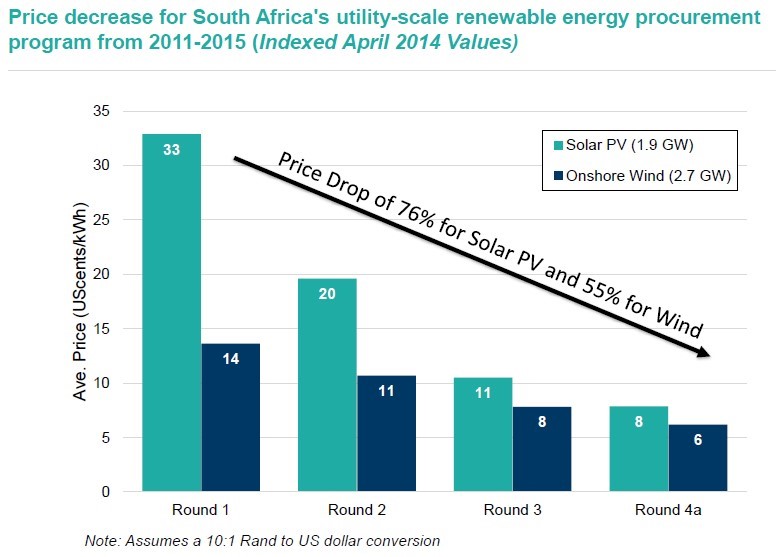
The recent success of South Africa’s renewable energy program demonstrates the need for a larger role for renewables in Southern Africa’s energy mix. South Africa’s Renewable Energy Independent Power Producer Procurement Program (REIPPPP) has procured ~5GW to date from Independent Power Producers (IPPs) in the first 4 rounds from 2011-2015. The biggest success story in this program is the impressive drop in price for these 20 year energy power purchase agreements. A 55% drop for onshore wind and 76% drop for solar photovoltaics (PV) from Round 1 to 4 shows how successful the program has been in securing affordable and much needed electricity for South Africa currently suffering from a supply shortage and regular load shedding. While solar PV and wind account for ~91% of the procured capacity to date, other technologies including concentrating solar power, small hydro, and biomass plants have also demonstrated their viability with various projects underway.
Compare this to the severe cost overruns and multi-year delays experienced from new coal power plants, and the needed direction for the regions energy sector seems clear. Many estimates suggest South Africa’s new coal plants, Medupi and Kusile (both ~4.8GW), will likely exceed 10 UScents/kWh (>R1.0/kWh) which is more expensive than the current price of both onshore wind and solar PV prices in South Africa. Moreover, the projects are still battling multi-year delays with Medupi already projected to cost three times more than initially approved by South Africa’s regulator. The challenges with these coal mega-projects are just another example of why the Southern African region should give priority to smaller and more scalable generation options like natural gas turbines and renewables built by IPPs.
South Africa’s Energy Minister, Tina Joemat-Pettersson, has taken notice of the success of the REIPPPP and recently announced plans to accelerate and expand the program by an additional 6,300 MW of renewable energy, effectively doubling its size. While still within the limits set by the IRP, this is uplifting news for the renewable energy industry, but the question remains if NERSA and DoE can work together to approve this quickly enough to have a meaningful impact for Eskom’s energy crisis.
Regardless of the timeline for the REIPPPP, it is clear that scalable and affordable renewable energy solutions are available which South Africa and Sub-Saharan Africa region as a whole should enable.
